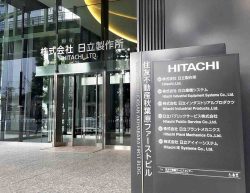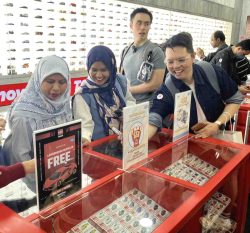
Toyota Motor Corp.’s electric sport-utility vehicle is seen at its world debut in Shanghai in April.
13:52 JST, May 16, 2021
Stronger than expected sales of Toyota Motor Corp.’s sport utility vehicles in the United States and China helped the company turn a ¥500 billion operating profit prediction into a ¥2.2 trillion financial reality for the fiscal year ending March 31.
During a press conference Wednesday, the carmaker also referred to its goal of selling 8 million electrified vehicles, including electric and hybrid cars, by 2030 as part of its efforts to promote decarbonization.
Kaizen-backed recovery
On a consolidated basis, Toyota’s operating profit stood at ¥2.2 trillion for fiscal 2020.
As of May last year, company President Akio Toyoda expected the group operating profit to tumble to ¥500 billion as he estimated the novel coronavirus disaster would have a more damaging impact than the 2008 global financial crisis.
But the firm revised its annual operating profit in February and set a new forecast at ¥2 trillion.
Toyota’s robust sales of SUVs and other profitable cars in the United States and China helped the firm turn a hefty profit. Its new vehicle sales in Japan have also risen higher on a year-on-year basis since last October.
For fiscal 2021, Toyota foresees the recovery continuing and envisages global sales surging by 5.6% from the previous year and hitting 9.6 million units.
Riding the global trend toward decarbonization, Toyota is predicting its hybrid vehicle sales will skyrocket by nearly 30%.
When including subsidiaries Daihatsu Motor Co. and Hino Motors Ltd., Toyota is for the first time in two years aiming for sales to exceed 10 million units worldwide. Vehicle sales are expected to reach 10.55 million globally for fiscal 2021.
The carmaker has promoted its production efficiency improvement efforts, known as kaizen. After it reviewed parts procurement costs as well as its plants’ distribution networks, Toyota was able to reduce expenditures by ¥150 billion.
“By improving cost[-efficiency], we were able to the lower the threshold of when units break even,” Toyota Chief Financial Officer Kenta Kon said at an online press conference Wednesday. The company also cut expenses by curbing business travel and other means.
While a global semiconductor shortage has left many players in the auto industry scrambling in search of solutions, it has barely made an impact at Toyota as the company had stockpiled inventory and secured alternative products.
After the 2011 Great East Japan Earthquake, Toyota began strengthening its relationships with semiconductor-related parts suppliers. Such measures enabled the company to be prepared for unforeseen circumstances.
Kon said that Toyota “incoroporated risks” in its fiscal 2021 sales plan.
Dawn of decarbonization
Looking to the future, one focus for Toyota is how to best respond to the growing global trend of decarbonization.
Toyota has indicated that it plans to sell 8 million electrified vehicles in 2030, including 2 million electric and fuel cell vehicles.
Previously, it had set a global target of 5.5 million electrified vehicles sold by around 2025, with at least 1 million electric and fuel cell vehicles in the total.
To improve production efficiency, Toyota is considering to build electric vehicles on the chassis model it uses for its hybrid and plug-in hybrid vehicles. The firm also plans to shorten the time it takes to develop electric vehicles.
Furthermore, Toyota plans on bolstering the performance of its hybrid and plug-in vehicles by increasing the proportion of electricity in the cars’ power sources. The production system is also expected to be strengthened.
“In order to achieve our 2030 targets, we will need to multiply the current battery supply by 30 times, and we need to go from the two electric-vehicle production lines we currently have to more than 60,” Toyota Operating Officer Jun Nagata said.
The carmaker has allocated a record high of ¥1.16 trillion to research and development for fiscal 2021. Other projects include beginning the full-scale development of hydrogen engines and “e-fuel,” a next-generation liquid fuel.
“We will look very actively at various options and technologies,” Nagata said. “Toyota will continue to be the top runner [in decarbonization].”
"Business" POPULAR ARTICLE
-

Keidanren Chairman Yoshinobu Tsutsui Visits Kashiwazaki-Kariwa Nuclear Power Plant; Inspects New Emergency Safety System
-

Imports of Rare Earths from China Facing Delays, May Be Caused by Deterioration of Japan-China Relations
-

University of Tokyo Professor Discusses Japanese Economic Security in Interview Ahead of Forum
-

Japan Pulls out of Vietnam Nuclear Project, Complicating Hanoi’s Power Plans
-

Govt Aims to Expand NISA Program Lineup, Abolish Age Restriction
JN ACCESS RANKING
-

Keidanren Chairman Yoshinobu Tsutsui Visits Kashiwazaki-Kariwa Nuclear Power Plant; Inspects New Emergency Safety System
-

Imports of Rare Earths from China Facing Delays, May Be Caused by Deterioration of Japan-China Relations
-

University of Tokyo Professor Discusses Japanese Economic Security in Interview Ahead of Forum
-

Japan Pulls out of Vietnam Nuclear Project, Complicating Hanoi’s Power Plans
-

Govt Aims to Expand NISA Program Lineup, Abolish Age Restriction























